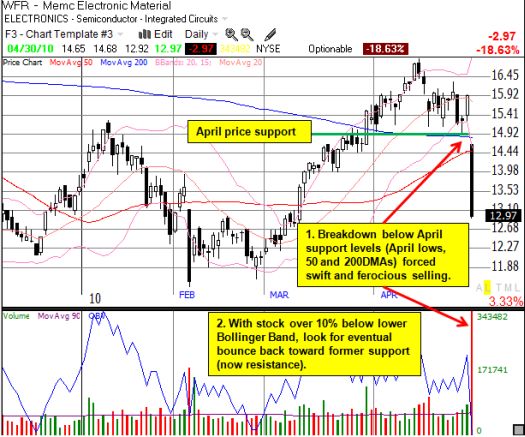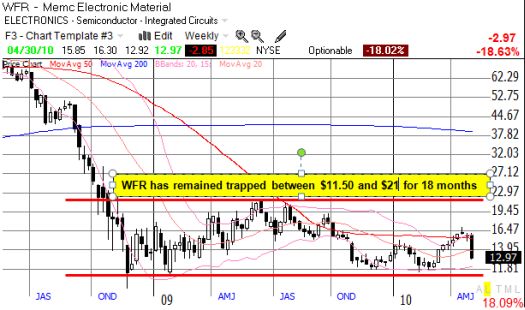MEMC Electronic Materials (WFR) manufactures silicon wafer solutions for the semiconductor and solar industries. WFR fell 19% on Friday in response to earnings despite the company’s reassurances that it is on track to meet full-year guidance targets (click here for the transcript from Seeking Alpha):
“In the first quarter, revenue was ahead of our internal expectations. On the other hand, profitability was below expectations. We made progress in several operational areas that will position us for improved margins on profitability as we progress through 2010. For the full year, we believe that we’re on track to meet our annual EPS and cash flow guidance and that revenue may exceed the high end of our previous range…
…we have good reasons to be cautiously optimistic about our future. Growth looks promising in all segments. I expect to see improvements in sales, margin, income and cash flow as we progress through 2010, with sales already expected to be above our previous guidance.”
It seems to me the selling was overdone given the company’s reassurances. Perhaps WFR’s commentary about the uncertainties and cost pressures in the solar business caused the over-reaction. While WFR is experiencing positive volume pressures in its solar business, costs are rising faster than price gains. For example, subcontractors unexpectedly drove their charges higher while WFR maintained commitments to its customers to lower prices last quarter. WFR expects to regain pricing power going forward (this could have implications for the earnings growth of WFR’s customers). Moreover, the company is unsure of the sustainability of this surge in demand given the rush to beat changes in Germany’s feed-in-tariff (FIT). Here are key quotes from the conference call on these topics:
Solar Margins:
“…the margin rate we are going to be able to generate in the Solar Materials business will be significantly lower than we planned. While demand remains strong and pricing had stabilized, the strategic challenge of not owning our own wafering operations will persist through this year and [will] cap our profitability in this business.”
Solar Demand:
“I think the discussion has flipped from the price is not good enough to the volume that you’re giving me is not good enough…we’re not convinced how sustainable the demand is…So we walk into the year thinking that the market’s going to increase but not that much. Then Germany, there was noise in there about reducing the feed and tariff rates. All of a sudden there was like an absolute anarchy in how much we can build power plants in Germany across many, many, many, many, many installers. And in that situation, then the demand for wafers skyrocketed.”
Solar Pricing:
“We could have easily turned around and raised price on our Solar customers. We just didn’t want to do it. While we’d have shown a much better result this quarter, but they would have missed all their plans and we just didn’t feel that that’s the right thing for us to do…now in Q2 we’re raising price, and the price is increasing as much as it declined from Q4 to Q1, it’s increasing from Q1 to Q2. And we see a firmness as well in Q3, but it’s still early, but so far so good.”
Solar Costs:
“So what happened is when we walked into Q1, we had, I would say gentlemen’s agreement and handshakes to have a cost roadmap for the year with our subcontractors. And as you know, a lot of them have a lot of pressure on them. And basically, those agreements were thrown out of the window within a few weeks, and the pricing increased dramatically from Q4 to Q1 rather than declining from Q4 to Q1.”
Clearly, the solar side of the business is quite messy. The semiconductor side of the business looks very promising with WFR indicating that it will recognize significant price increases in its semiconductor business.
The market is expressing its skepticism about WFR’s prospects with almost 10% of shares sold short, and a stock price that has gone absolutely nowhere in about 18 months. The latest selling is part of a regular pattern of churn up and down through this extended trading range. The daily chart below shows the near-term over-extension. The weekly chart shows the longer-term stagnation. I am looking to play WFR for another bounce from the bottom of its trading range. If solar demand and pricing somehow remain at least stable in the second half of this year, WFR could quickly outperform and challenge the top of the trading range again around $20. With over 50% potential upside and about 8% downside, the risk/reward looks very good here.


*All charts created using TeleChart:

Be careful out there!
Full disclosure: no positions
